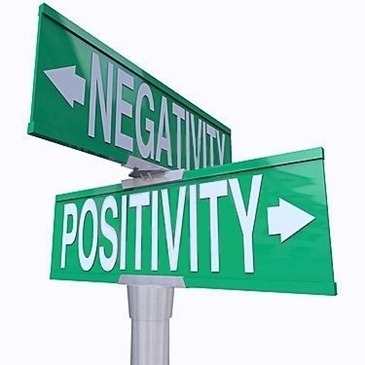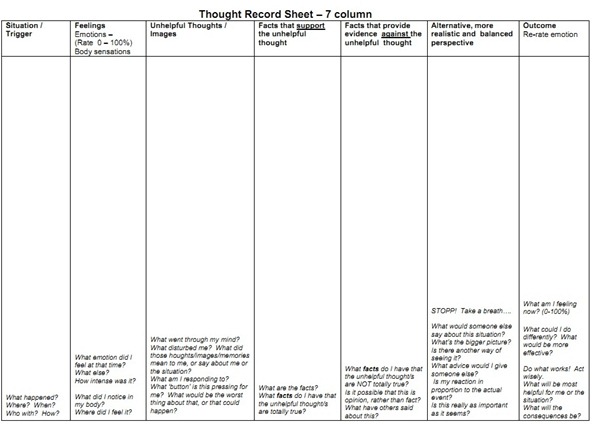
Many of you have asked me if I could talk about things I have learned in therapy since I announced back in the summer that I was going back into therapy for my struggles with anxiety.
Well, first off, I didn’t end up going right away. It took me about 1.5 months to find a therapist who would fit my budget. After a long search, I found a very nice lady who offers a sliding scale because her therapy office is based out of a church. I had almost given up on it and then was thrilled when I found her.
My therapist uses a multimodal approach with a focus on Cognitive Behavioural Therapy, which helps us understand how our thoughts and feelings influence our behaviours. CBT was also one of my favourite forms of therapy that I learned about in grad school.
We all have thoughts that tend to be so automatic we don’t question or challenge them. For example, “I’ll never be able to find a job that I love because I’m not exceptional at anything.” or “It must be my fault that they don’t like me because there’s something wrong with me.” It’s amazing when you stop and think about how many negative thoughts go through the mind each day.
CBT helps bring awareness to these thoughts that lead us to have incorrect beliefs about ourselves and our situations. In the past, I’ve had great success when using CBT methods, especially when in recovery for my eating disorder.
In therapy, we’ve been able to identify that a large part of my anxiety is due to personal issues from my past and also that I make false assumptions and predictions about events in the future. I tend to predict that a situation will go poorly, when in fact, I have no evidence that this is the case.
One of my favourite forms of CBT is the Thought Record. The great thing about it is that it can be used by anyone, anywhere.
The Thought Record has been very helpful for me to reframe automatic thoughts. The more you use it, the easier it is to fill out and catch your negative thoughts in the process. Once you practice, you can even start doing it in your head if you find yourself in the middle of an anxiety-provoking situation.
If you click the image below, the Thought Record will pop up in PDF format that you can print for yourself.

Here’s an example of what each column means:
1. The situation/trigger. Briefly describe the situation that led to your unpleasant feelings.
For example, “a work presentation”.
2. Feelings. What do you feel?
For example, “Anxiety, guilt, doubt, fear.”
3. Unhelpful thoughts/images. Identify the negative thinking (or “hot thought”) behind your feelings.
For example, “My presentation is going to go horrible and my boss is going to think that I’m bad at my job. I’m a failure.”
4. Facts that support the thought. Find evidence that supports your unhelpful thought.
For example, “My boss has told me in the past that she’s disappointed with my presentation skills.” and “I didn’t prepare as much as I should have.”
5. Facts that don’t support the thought. Facts that provide evidence against your unhelpful thought.
For example, “I have worked on my presentation skills since my poor review and I have improved.” and “I’m not a failure and I’m doing my best.” and “Everyone has bad days at work.”
6. Give an alternative/more balance thought. Now that you’ve considered the facts, write down a healthier way of thinking.
For example, “While I have struggled with presentations before, I’ve practiced and prepared for this presentation and have no proof that this will not go well.”
7. Outcome. Re-rate how you feel now.
“Less anxious” “calmer” “reassured”
That’s just one small example that it can be used for, but it can be applied to so many different types of situations, thoughts, and personal struggles. It’s a really helpful tool to use for body image issues because many of us tend to have automatic negative thoughts about our body that can impact our entire day. Sometimes all you need is to re-frame your thought and move on with your day.
Of course, it takes a bit of practice to be able to reframe a thought (and find evidence that doesn’t support it), but it will get easier over time. Also, not every thought record that you do is going to be life-changing, but I can assure you that some of the ones I have done have really impacted me.
The first time I did the thought record with my therapist, I had this major ‘a-ha’ moment. She helped me write a more balanced thought (I actually couldn’t think of one, so she filled one out for me) and it brought me to tears because something just clicked inside of me. It was amazing how it helped me see a situation in a new light that I’d never thought about before. That one moment has had a huge impact on how I now think about the situation.
The Thought Record makes my thoughts more realistic and balanced, when anxiety tends to make them very up and down and unbalanced. With practice it helps you slow down or stop those automatic thoughts in their tracks. I find that I can “catch” them fairly quick now, recognize them for what they are, and realize that my thinking is not realistic or fair. It sure beats going along in life accepting every negative thought that comes to mind.
If you feel yourself stuck on an issue, try using the Thought Record. It may just help you see something in a new way!





I opened your blog today looking for something – I wasn’t sure what, but I’ve been having an “off” week. You provide such a positive message no matter what the subject matter, which is why I felt drawn to you today. Thank you for shining your Light to the world through this blog. I don’t think you know how many people you influence through your sharing – thank you thank you thank you!
I have tried many of your recipes as I am very passionate about healthy eating. I also happen to work for a company that shells flax. I thought as a thank you I would like to provide you with a package of our delicious flax which you don’ t need to grind or keep it in the fridge! It is also 100% Canadian. :)
Best Regards and keep up the good work,
Barbara
Thank you so much for sharing this!
Thanks so much for sharing this. :) I’ve never seen a thought record before.
Thanks for sharing this! CBT is my favourite form of therapy, and I hope to use it in the future when I become a registered psychologist. I want to work with people who have OCD and/or eating disorders.
Angela thank you for this post. It feels so good to know I’m there are others that are dealing wtih similar things. Meditating on positive affirmations is so helpful for fighting negative self talk. On days that I meditate, I feel so much more positive, self accepting and in control of my thoughts. Thank you for the thought record. I can’t wait to try it!
This post came at exactly the right time for me. This has been such a stressful week, I’ve lost track of the number of times I panicked and cried about something. Thanks so much for sharing. I will definitely try this in the future.
Thank You for this, I’m seeing someone new to assist me with my anxiety and eating disorder also. This can be a useful for a tool for her with other clients also. Thanks! :)
Thanks so much for this tool, when we think positive thoughts it so helps us in all aspects of our lives….making healthy choices and feeling good about ourselves and all the people in our lives….you are truly an inspiration.
Making false predictions about future events and assumptions about what others are thinking is me to a tee. I will definetely be trying the thought record. Your honesty really helps others not feel so alone in their issues. Thanks!
I have been following your blog for a couple of months now, and with my 30th birthday looming … I think I am ready to make some drastic healthy changes! You are an ispiration!
Thank you Kay…goodluck and happy birthday!
You’re so wise for someone so young. Thank you for this entry, especially!
Angela- I have been following your blog for over a year now, but this is my first comment! Just wanted to thank you for always being so open and sharing the thought record pdf. Such a wonderful tool to have when emotions and feelings get overwhelming. I enjoy your posts so much!
It appears I’ve struggled with anxiety all my life for as long as I remember. I have adopted many maladative coping mechanisms and refused to see myself as someone who has mental problems so I never seeked help. I have found this blog extremely useful, even heaven-sent, and am looking forward to using the thought record. I have also been using Jon Kabat-Zinn’s mindful meditation tapes and book “Full Catastrophe Living” that gives you strategies on how to deal with different types of stress as well as many relaxation techniques and yoga exercises. Thanks for the blog, Angela, and hope you have more similar entries.
I love the idea of practicing to retrain your thoughts. Negativity is definitely a habit, and one that can be broken, but breaking habits doesn’t happen easily. I was recently reading an article about habits that says over 50% of our actions are caused by habits (http://creationbasedhealth.com/lifestyle-habits/). It also mentions that there are always triggers for habits. I think I’m going to practice this to see what my triggers are for negative thinking and to see what I am thinking that’s not supported by facts!
Thanks!
I love CBT! I had that same click moment with automatic thought records and I still use them to help re-frame events causing me anxiety. Before I started them I had no idea why I would feel anxious.. it didn’t even seem connected to specific events. It really helped outline where and why I felt anxious and all the negative ‘should’ ‘should not’ type thoughts running through my head. I also like that its a skill to build on so I don’t feel bad if I need to keep practicing at it because it’s a process rather than a quick fix.
Since I began CBT, and doing Thought Records, I have found an improvement in my moods. After being in therapy for 9 months I could do thought records in my head. I have been diagnosed with Clinical Depression and Anxiety Disorder and my mood swings fluctuate wildly. When I feel “good” I don’t need thought records, but as daily stressors begin to fill my “bucket” and my emotions heighten, just when I need the records I find them difficult to do without the help of a therapist. In my case it is better to do a TR even for the smallest negative thought, that way I keep on top of things. In my case, meds are important as well. The combination of therapy and CBT and Rx helps keep a relatively stable me.
I am so glad to see that I am not the only one who has these issues. I’m constantly being told to stop being so negative and that if I tried harder I would be “Normal” ie no anxiety. As if anyone would wish this upon themselves. Thanks for the CBT idea. I’ve tried the TR and found them to be very effective, but for some reason, when I’m stressed I find them very difficult to do.
Great article. I’ve never used thought record before but I will definitely try it. I am recently having negative thoughts that I want to remove. They are eating myself from inside. I’m sure that this new (for me) method and these moving forward quotes http://hardquotes.com/life-motivational-quotes/quotes-about-moving-on-life will help me get through this.
Thank you for the “How to Reframe a Negative Thought” worksheet. I’m a psychology student and I think this is very useful tool.
Agi